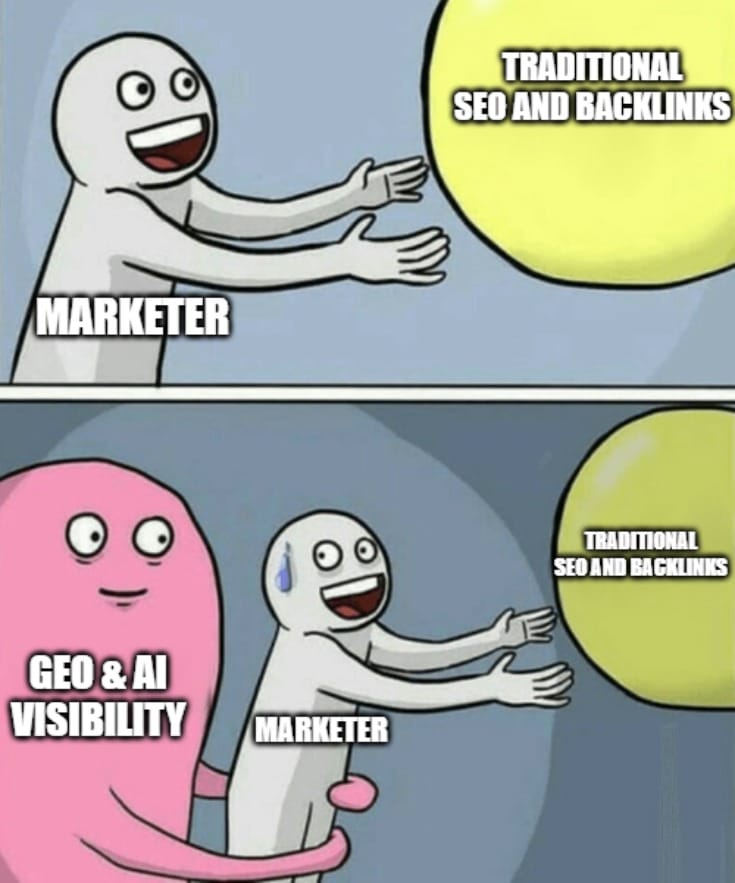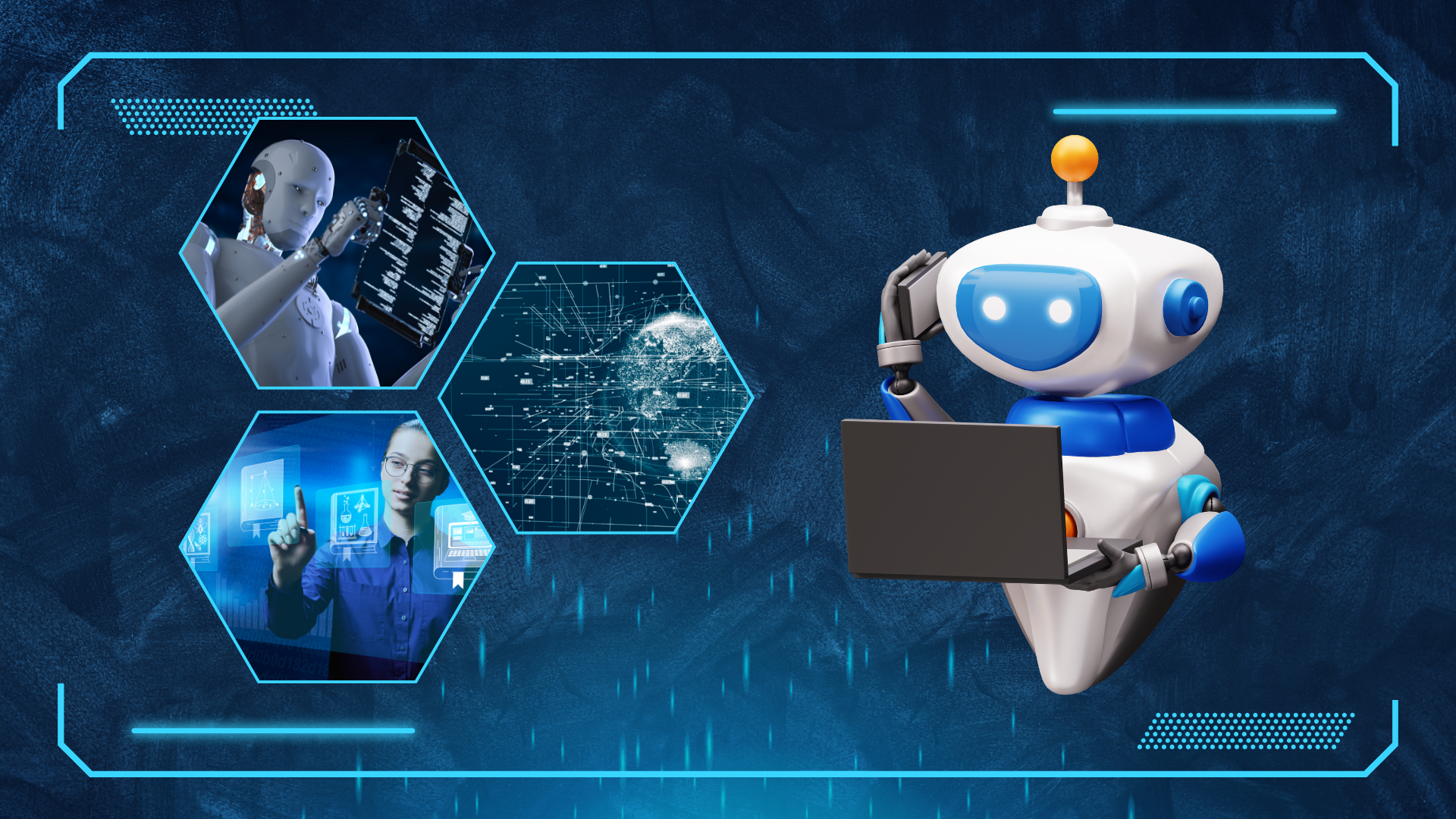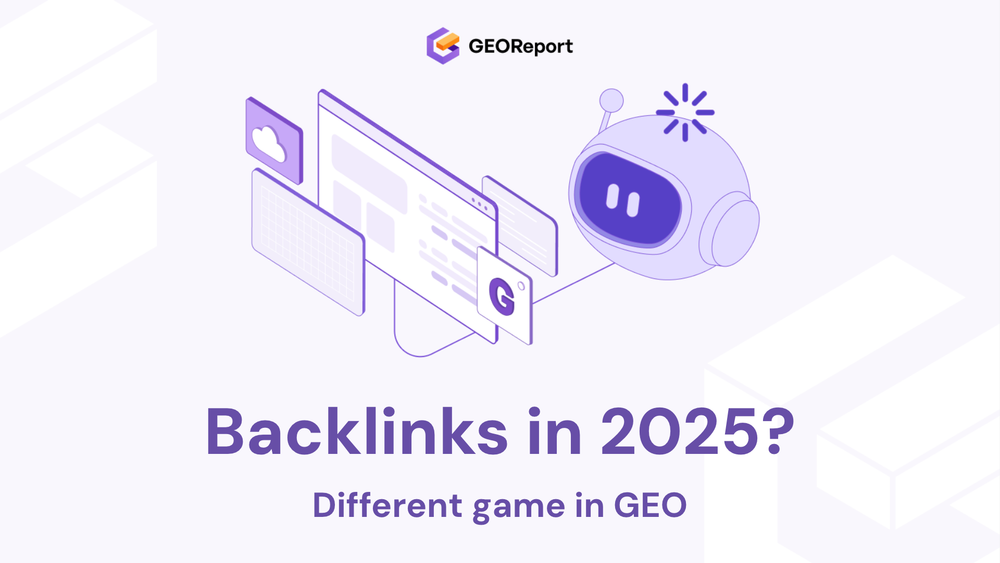BLUF:
AI didn’t kill backlinks, it redefined them. In the age of Generative Engine Optimization (GEO), authority is no longer measured purely by hyperlinks. It’s determined by how well AI systems can interpret, verify, and cite your brand as a trustworthy source. Backlinks built the web, AI citations are building the new layer of visibility on top of it.
The Myth: “Backlinks Are Dead”
Every time a new technology shifts the digital landscape, someone claims the old foundation is obsolete. We’ve heard “SEO is dead” for over a decade, and now the same narrative targets backlinks. Some even argue that generative AI has made links irrelevant, since users no longer click, they just read summarized answers.
But this is a shallow interpretation of how information authority actually works in the AI era. Backlinks were never just about traffic, they were signals of trust, reputation, and networked relevance. And those are precisely the things AI still depends on.
Google’s Search Generative Experience (SGE) continues to rely on link graphs, crawlability, and contextual relationships between domains. Similarly, OpenAI’s retrieval models, which power ChatGPT Search and Perplexity AI, still retrieve from index-based link networks before generating responses. The structure hasn’t vanished, it has evolved. Backlinks still feed the infrastructure of authority that AI models interpret, only now, that authority must be machine-legible.
From Backlinks to AI Citations
In traditional SEO, backlinks served as endorsements, each link was a human expression of “this source is valuable.” In the GEO era, AI citations play the same role, but through machine interpretation instead of human judgment.

When an LLM cites your content in a generative answer, it isn’t “linking” in the conventional sense, it’s recalling your entity from its knowledge graph because it recognizes your content as contextually relevant and trustworthy. The difference is structural. Backlinks build pathways between documents, AI citations build context maps across semantic meaning.
A backlink says, “This site refers to that one.” A citation says, “This idea aligns with that one in meaning and reliability.” In that shift, GEO doesn’t replace SEO, it extends it into a new dimension.
| Signal Type | SEO Era | GEO Era |
|---|---|---|
| Core Mechanism | Backlinks | AI Citations |
| Evaluator | Human behavior & search algorithms | Machine reasoning & generative engines |
| Trust Definition | Referral-based authority | Interpretive credibility |
| Data Form | Hyperlink graph | Knowledge graph / entity mapping |
| Primary Goal | Ranking | Recommendation & citation |
The takeaway is clear: backlinks measure connection, while citations measure comprehension. AI visibility is no longer about being linked, it’s about being understood.
Why AI Models Need GEO Signals
To understand why backlinks alone can’t sustain visibility, we have to look at how AI engines actually “see” the web. Large Language Models don’t read hyperlinks, they read relationships. They process text through vector embeddings, where meaning is captured through proximity in multi-dimensional space.
In that space, a hyperlink means little, but consistent entities, structured schema, and clear E-E-A-T signals mean everything. This is where GEO becomes the bridge between SEO’s surface structure and AI’s reasoning layer.
An AI doesn’t care if Forbes links to you, it cares if your brand, author, and topic consistently appear in factual, verifiable contexts across the web. If your data markup, author profiles, and tone coherence are aligned, you’re far more likely to be interpreted as a reliable entity worth citing.
That’s why brands like Investopedia or Harvard Business Review often appear in AI summaries even when smaller, more optimized sites have better backlinks. They’ve built semantic credibility, not just link equity.
The New Authority Chain
The evolution from backlinks to AI citations can be seen as a shift in the layers of trust online.
- Base layer, SEO still manages the link graph, crawlers connect pages and rank them by interlink density and relevance.
- Middle layer: GEO manages the knowledge graph, AI engines connect entities, ideas, and trust signals to form interpretive context.
- Top layer: This sits the reasoning layer, where generative AI decides which entities to cite or summarize.
These layers don’t replace each other, they reinforce one another. SEO provides discoverability, GEO provides interpretability, and AI provides visibility. If one fails, the others weaken.
For example, if your content isn’t crawlable (SEO gap), AI can’t retrieve it. If it’s crawlable but lacks schema or author transparency (GEO gap), AI can’t understand it. If it’s understood but inconsistent across sources (trust gap), AI won’t cite it. Authority, in this model, is cumulative, not competitive.
Case Study: When Smaller Brands Outperform Giants
In our GEOReport audits, we’ve seen a clear pattern — smaller, well-structured brands are starting to outperform household names in AI-powered search.
Take a simple example: when users ask “best running shoes under $150,” Google’s top results are still dominated by the usual SEO giants like Nike, Adidas, or Runner’s World. But in ChatGPT or Gemini, the AI-generated answers often highlight niche brands like Allbirds, Hoka, or On Running — companies that communicate in ways AI can actually understand.
These challenger brands don’t necessarily have bigger budgets or backlink networks. What they do have is structure. Their product pages use clean schema, their FAQs answer real user questions, and their tone is educational, not promotional.
Meanwhile, traditional sites rely heavily on historical SEO equity — backlinks, domain age, and brand recognition — signals that AI no longer weighs the same way. Generative engines don’t rank links; they reason through clarity, credibility, and context.
That’s why smaller, data-driven teams are quietly winning. They’re not just optimizing for search; they’re optimizing for understanding. And that’s the real shift from SEO to GEO.
The Future of Linkbuilding: From Links to Meaning
If backlinks were the foundation of the web’s “trust economy,” GEO citations are the foundation of AI’s “meaning economy.”

In the SEO world, building links meant persuading other humans to vouch for your content. In the GEO world, it means persuading machines to interpret your content as contextually authoritative. That requires consistency across multiple surfaces: your brand’s schema markup, author reputation, external references, and topical alignment across pages.
It’s no longer about “getting linked,” it’s about “getting understood.” Future linkbuilding will look less like outreach and more like ontology design, defining your brand’s position in the web of meaning. It’s a move from quantity to quality of interpretation.
When Google introduced E-E-A-T (Experience, Expertise, Authoritativeness, Trustworthiness), it was the first glimpse of this transition. Those principles were never purely human, they were precursors to how AI now interprets source credibility.
GEO takes that further by encoding these trust factors into structured data and relational signals that LLMs can parse. The better your brand’s digital fingerprint aligns across platforms, the more likely AI will treat you as a reliable node in its reasoning process.
Why Backlinks Still Matter, But Differently
It’s important to be clear: backlinks aren’t disappearing. They remain the infrastructure that defines which sources exist, how they connect, and how discovery flows. But what’s changing is how that infrastructure is interpreted.
A backlink from a reputable site still carries authority, but if the destination content isn’t structured for AI comprehension, the authority stops at Google. In contrast, even a modest backlink, combined with strong entity clarity and schema consistency, can travel up the visibility chain into AI citations.
GEO doesn’t replace the importance of linkbuilding, it reveals whether your links actually translate into comprehension. The future of SEO is not linkless, it’s meaning-first. Backlinks are still the currency of discovery, but GEO defines whether that currency is convertible in the AI economy.
The GEO Trust Framework
Think of the evolution like this: SEO measures who mentions you, GEO measures how AI understands you, and together they define why you’re remembered.
This new trust framework is built on three pillars:
1. Structural Trust: Still grounded in backlinks, domain authority, and crawlability. Without it, AI has nothing to parse.
2. Interpretive Trust: Derived from schema markup, entity alignment, and author verification, the foundations of GEO.
3. Behavioral Trust: Reinforced through consistency across touchpoints (social, reviews, publications) that teach AI your identity is stable and reliable.
The interplay of these three defines your AI visibility loop. SEO gives you existence, GEO gives you essence.
The Future: One Visibility System
By 2026, the distinction between backlinks and citations will blur. As AI models continue integrating web data, the line between ranking and reasoning will fade into one continuous visibility system.
The most successful brands won’t just build backlinks, they’ll build semantic ecosystems. Their websites, social profiles, and publications will act as interconnected evidence of authority. GEO won’t kill SEO any more than Web3 killed Web2, it will abstract and enhance it.
Where backlinks were static endorsements, GEO citations are dynamic validations. The goal of optimization is shifting from ranking higher to being remembered longer.
In this hybrid future, your SEO efforts feed your GEO potential, and your GEO structure validates your SEO signals. Brands that understand this feedback loop will dominate AI-powered discovery because they’re optimizing not just for clicks, but for comprehension.
Authority will no longer belong to whoever gets linked most, it will belong to whoever is interpreted best.
How GEOReport Helps You Lead the New Visibility Stack
1. GEOReport — The Evaluation Layer
Most marketers still optimize content, backlinks, or schema in isolation. GEOReport changes that by acting as the evaluation layer — unifying every visibility signal across SEO and GEO. It doesn’t compete with your backlink tools or on-page optimizers; it governs them. GEOReport turns disconnected SEO metrics into an integrated map of AI trust, revealing how your brand is interpreted, cited, and remembered by generative engines.
2. Integrating Backlink Intelligence into AI Context
Traditional backlink data tells you who links to you; GEOReport tells you why AI trusts you. It translates backlinks, mentions, and domain authority into measurable GEO signals — such as entity clarity, semantic trust, and citation likelihood. By doing so, it bridges your SEO groundwork with your AI visibility outcomes, turning every link into an interpretable context node.
3. Measuring Entity Confidence and E-E-A-T Consistency
GEOReport audits how consistently your brand’s Experience, Expertise, Authoritativeness, and Trustworthiness (E-E-A-T) are represented across your ecosystem — from web pages to external mentions. This becomes your “AI trust score,” showing where your credibility holds strong and where it weakens in AI reasoning chains.
4. Structured Data and Schema Validation at Scale
AI engines don’t read design — they read structure. GEOReport identifies missing schema, broken markup, or misaligned entities that make your content invisible to AI crawlers. It provides targeted recommendations so that every piece of content contributes to your brand’s machine-readable identity.
5. Competitive Benchmarking Across AI Engines
GEOReport compares your visibility footprint with competitors across ChatGPT, Gemini, Claude, and Perplexity, revealing where others get cited first and why. It dissects the underlying signals — entity trust, schema quality, topical authority — that drive those results, helping you build authority that’s both explainable and defensible.
Insight:
GEOReport isn’t another analytics tool — it’s the system that interprets the entire visibility stack. It connects what SEO built (links and traffic) with what GEO now governs (trust and citations), turning your data into a living knowledge graph AI can understand and elevate.
FAQs
Are backlinks still relevant in 2025?
Yes, they remain the backbone of web discovery, but their role has shifted from ranking input to credibility context. GEO doesn’t replace backlinks, it determines which backlinks translate into AI-visible authority.
What exactly is an AI citation?
An AI citation is when a generative engine like ChatGPT, Gemini, or Perplexity references or incorporates your brand, article, or dataset as part of its synthesized answer. It’s a signal that your content has been recognized as a credible node in the AI reasoning process.
How can I make my backlinks “GEO-ready”?
Focus on schema markup, consistent author metadata, and contextual linking. Make sure your link destinations are rich in structured data and readable by both humans and AI.
Can small websites compete with large ones in this new model?
Absolutely. GEO rewards clarity, transparency, and structured trust. Small, specialized sites that communicate consistently across entities and platforms can outperform bigger brands that rely solely on legacy authority.
How should I measure success in this era?
Track not only backlinks and rankings but also brand mentions, AI citations, and sentiment across AI-generated outputs. Use tools like GEOReport.ai to audit your AI visibility and citation footprint.


